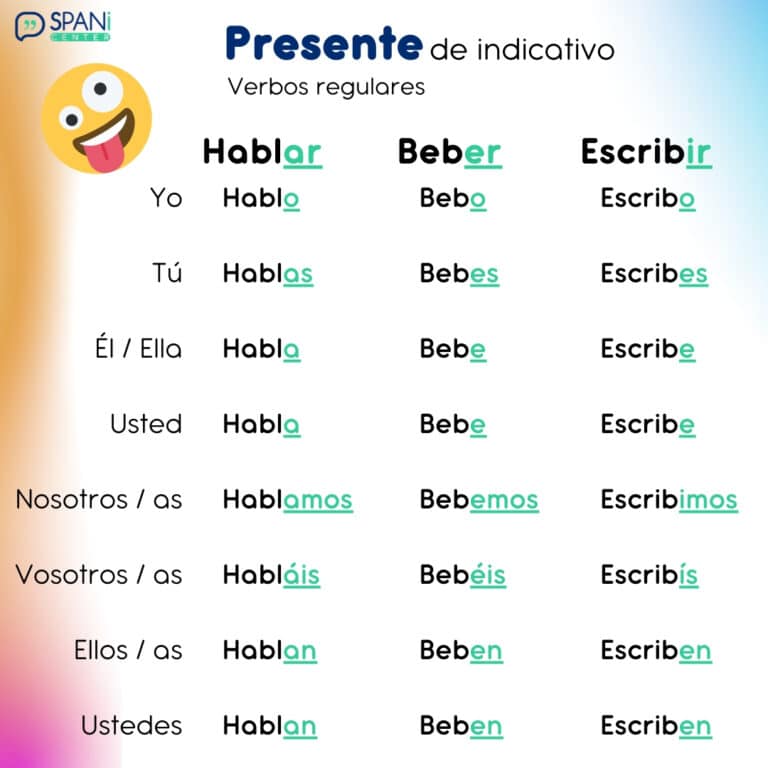

Verbs with Spelling Changes in the Indicative Yo Form You ready? -What, do you want me to eat the same thing?Ĭaption 43, Factor Fobia Cucarachas - Part 1 Play CaptionĬaption 43, Muñeca Brava 33 El partido - Part 6 Play Caption

¿'tas listo? -¿Qué querés que yo coma lo mismo? Now, let's see these Spanish present subjunctive verbs in action:īecause I want us to talk about business.Ĭaption 3, Muñeca Brava 8 Trampas - Part 6 Play Caption You will note that in the present subjunctive, the yo form and the él/ella/usted form are exactly the same. er/-ir verbs:Īrmed with this information, we can easily conjugate these verbs in the present subjunctive in Spanish. Now, let's look at the present subjunctive endings for -ar vs. Let's use the aforementioned formula to get the stems for three of the most common regular verbs: We then remove the -o in order to get the stem and add the corresponding endings for -ar and -er/-ir verbs, which we can think of as the "opposite" of the endings for each verb class in the present indicative. The first step in conjugating most verbs in the present subjunctive is to recall the present indicative yo (I) form of the verb. Rather than e spero que practican en su casa because the verb tense changes from the indicative ( practican) to the subjunctive ( practiquen) due to the "hope" regarding whether the action will take place. In another lesson, we will explore the many scenarios in which the Spanish subjunctive mood comes into play.Ĭonjugating Verbs in the Present Subjunctive in Spanish As a simple example, if you say, "I hope you practice at home" with ustedes (plural you) in Spanish, the correct manner of doing so would be:Ĭaption 60, Lecciones de guitarra Con Cristhian - Part 3 Play Caption banner2 PLACEHOLDER An Example of the Present Subjunctive in Spanish:īefore going on to conjugation, let's see an example of the present subjunctive in Spanish, which typically appears after the present indicative in dependent clauses connected by a coordinating conjunction such as que (that). The focus of today's lesson will be the conjugation of the Spanish present subjunctive tense. She says…“Think yo, drop the -o, -a to -e, and -e to -a.” This rhyme helps her to remember that, “in order to form the subjunctive, I have to think in the yo form, drop the - o at the end of it and then change the –ar verbs to –er verbs and the –ir and –er verbs to –ar endings.The present subjunctive in Spanish is one of the many verb tenses in the Spanish subjunctive mood. The subjunctive mood is one of three moods in Spanish (the indicative, the imperative, and the subjunctive) that indicates the presence of doubt, emotion, or subjectivity, in contrast to the indicative, which states facts.
SUBJUNCTIVE ENDINGS SPANISH HOW TO
Sam uses a rhyme to remember how to form the conjugation of the verb in the subjunctive. Two rhymes "Think yo, drop the –o, - a to - e and -e to –a”

What's the reason for using one strategy or another?.Using L1 to keep forms and functions straight.English sentences with Spanish words inserted.I'm looking for strategies that match my learning style and that can apply to various grammar forms. Reflexive pronouns in present perfect constructions.Direct and indirect object pronouns in affirmative and negative tú commands.Simultaneous use of direct and indirect object pronouns.Conditional perfect and pluperfect subjunctive.I'm looking for a strategy that someone has used successfully to learn a specific grammar form.


 0 kommentar(er)
0 kommentar(er)
